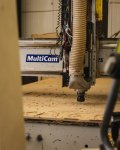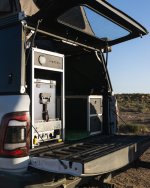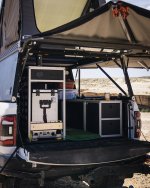driven.to.roam
New member
My experience has been as follows:
1. Marine plywood will stay together and not delaminate after getting rained on. It is pretty soft, so it will get gouged up if used as a floor without a hard finish or layer bonded to the top.
2. An alternative is cabinet-grade wood (It has more plys and is very stiff) and sealing the edges well with fiberglass resin. You can also skin the surface with fiberglass cloth (I did this for my removable platform, as it's stiff and also slippery, so that I can slide the cooking unit out by myself). Fiberglass is messy and labor intensive, so it's a judgement call here.
3. It's hard to 100% seal the tailgate and the place where your tailgate meets the back glass of a typical camper shell, so you should expect that the last 12" of a camper interior and/or the floor in that area will receive a bit of water spray from time to time. It will also get left open occasionally too.
Most driveways slope downward, so any water that gets in will end up right around the last few inches of floor.
That’s really great feedback. Thank you! We’re trying to use as much marine grade or weather resistant material as possible.




